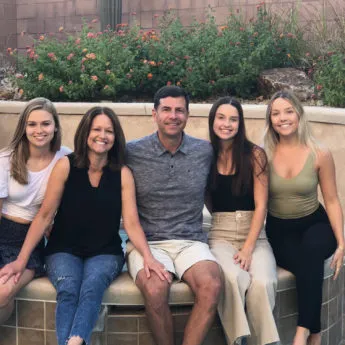Paul Lewis: Coronary Artery Disease and Heart Attack

Paul Lewis tells people that his life was saved by COVID-19. In March 2020, at age 52, he suffered a massive heart attack along with cardiac arrest and a minor stroke. Fortunately, however, the start of the pandemic caused a series of happenstance events to converge that put him in the right place at the right time to get help from a host of caring heroes.
“The doctors said that the chances of me surviving what happened to me in the field were very slim,” said Paul. “The chances of me surviving if I experienced it at an emergency room only improve slightly because of what happened.”
Paul’s heart attack was caused by multi-vessel coronary artery disease, in which more than one coronary artery is affected by blockages, and high-percentage stenosis, which means his blockages were significant. Dr. Emmanouil Brilakis, a Minneapolis Heart Institute® cardiologist who saw Paul in the ER, explained to him later that he had vulnerable plaque. It is a type of plaque in the arteries that is particularly unstable and prone to ruptures that can cause sudden major heart problems such as heart attack and stroke. Patients with this kind of plaque may not feel symptoms, as was the case with Paul. Although he had a family history of heart disease with his father having a heart attack at age 65, Paul led a healthy lifestyle and never imagined he could have a heart attack at his age.
“I’m a commercial pilot. I have a medical exam every six months. I could have maybe mixed in a salad instead of a hamburger once in a while, but I was relatively healthy, never smoked, didn’t drink excessively, all of that stuff.”
Saved by heroes
Paul had just gotten home from a trip on a Thursday in mid-March, right as Minnesota was preparing for its first stay-at-home order to try and slow the spread of COVID-19. The next day, as local schools were getting ready to close and move to distance learning, he decided to go for a late-afternoon run. Without any symptoms or warning, he suddenly collapsed face first in front of a school near his Lakeville home.
Luckily, several teachers were outside handing out iPads to students’ parents in the parking lot. His bright yellow hat caught the attention of one of the teachers, who saw him on the ground and immediately ran over to help. In the next stroke of luck, Brian Waits, who is the charge nurse for the cardiac ICU unit at Abbott Northwestern Hospital, just happened to be driving by. Waits jumped out of his car and began administering CPR, while school staff called 911.
“Brian stops with his four-year-old son in the car and just pulls over to the side of the road and does what he does,” said Paul. “He’s a caregiver. And he gave care and saved my life. That’s why I say I was saved by COVID, because if not for him, I wouldn’t be here.”
Paul was taken by ambulance to Fairview Ridges Hospital, where his lungs began filling with blood. After doctors there stabilized him, he was taken by ambulance to the Heart Hospital at Abbott Northwestern Hospital. Dr. Brilakis happened to be on call, who serves as director of the Center for Complex Coronary Interventions at the Minneapolis Heart Institute® and chairman for the Center for Coronary Artery Disease at the Minneapolis Heart Institute Foundation. The center has built a world-class reputation for innovative research on coronary artery disease and life-saving treatments and Dr. Brilakis is one of the foremost experts on complex percutaneous coronary intervention (a minimally invasive procedure to open blocked coronary arteries).
“I was pretty much not going to make it when I showed up at Abbott,” said Paul. “They looked at my heart and it was a mess. Even Dr. Brilakis, who I didn’t know at the time but discovered later is one of the best critical high-risk percutaneous physicians, said he couldn’t fix it and they needed to do a bypass.”
After consulting with other cardiologists, the doctors agreed that he was a good candidate for bypass surgery due to his relatively young age and good health. Four days later, Dr. Thomas Flavin, a Minneapolis Heart Institute® thoracic surgeon, performed a successful quadruple bypass surgery.
Paul is back to doing the activities he enjoys, including jogging, playing golf and spending time with his wife and three daughters. While he wasn’t yet back at work as of the summer of 2021, he was hopeful to get cleared by the FAA to fly again soon. He’s extraordinarily grateful for all of the wonderful individuals and health care professionals who helped save his life.
“I feel lucky to be alive, lucky to be doing the things I’m doing because, knock on wood, I haven’t had complications that have affected my life,” he said.

